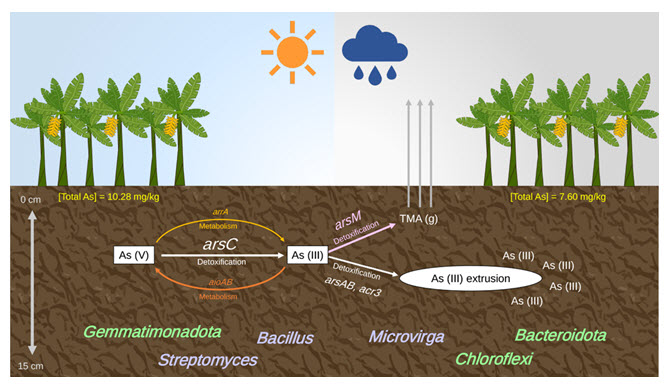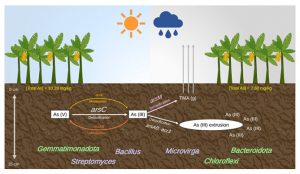Highlight Activities 2024: The role of microbiomes in cooperative detoxification mechanisms of arsenate reduction and arsenic methylation in surface agricultural soil
The role of microbiomes in cooperative detoxification mechanisms of arsenate reduction and arsenic methylation in surface agricultural soil
Microbial arsenic (As) transformations play a vital role in both driving the global arsenic biogeochemical cycle and determining the mobility and toxicity of arsenic in soils. Due to the complexity of soils, variations in soil characteristics, and the presence and condition of overlying vegetation, soil microbiomes and their functional pathways vary from site to site. Consequently, key arsenic-transforming mechanisms in soil are not well characterized. This study utilized a combination of high-throughput amplicon sequencing and shotgun metagenomics to identify arsenic-transforming pathways in surface agricultural soils. The temporal and successional variations of the soil microbiome and arsenic-transforming bacteria in agricultural soils were examined during tropical monsoonal dry and wet seasons, with a six-month interval. Soil microbiomes of both dry and wet seasons were relatively consistent, particularly the relative abundance of Chloroflexi, Gemmatimonadota, and Bacteroidota. Common bacterial taxa present at high abundance, and potentially capable of arsenic transformations, were Bacillus, Streptomyces, and Microvirga. The resulting shotgun metagenome indicated that among the four key arsenic-functional genes, the arsC gene exhibited the highest relative abundance, followed by the arsM, aioA, and arrA genes, in declining sequence. Gene sequencing data based on 16S rRNA predicted only the arsC and aioA genes. Overall, this study proposed that a cooperative mechanism involving detoxification through arsenate reduction and arsenic methylation was a key arsenic transformation in surface agricultural soils with low arsenic concentration (7.60 to 10.28 mg/kg). This study significantly advances our knowledge of arsenic-transforming mechanisms interconnected with microbial communities in agricultural soil, enhancing pollution control measures, mitigating risks, and promoting sustainable soil management practices.
สนับสนุน SDGs เป้าหมายที่ 3 Good Health and Well-being, 6 Clean Water and Sanitation และ 15 Life on Land
อ้างอิง
Rueangmongkolrat N, Uthaipaisanwong P, Kusonmano K, Pruksangkul S, Sonthiphand P. 2024. The role of microbiomes in cooperative detoxification mechanisms of arsenate reduction and arsenic methylation in surface agricultural soil. PeerJ 12:e18383 https://doi.org/10.7717/peerj.18383


